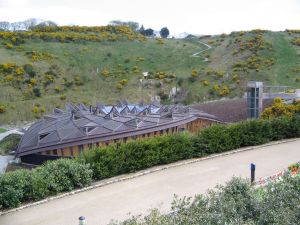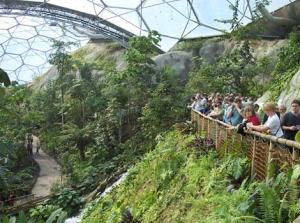The Eden Project is a visitor attraction in Cornwall, England, United Kingdom. Inside the artificial biomes are plants that are collected from all around the world. The project is located in a reclaimed Kaolinite pit, located 2 km (1.2 mi) from the town of St Blazey and 5 kilometres (3 mi) from the larger town of St Austell, Cornwall.
The complex is dominated by two huge enclosures consisting of adjoining domes that house thousands of plant species, and each enclosure emulates a natural biome. The domes consist of hundreds of hexagonal and pentagonal, inflated, plastic cells supported by steel frames. The first dome emulates a tropical environment, and the second a Mediterranean environment.
Design and construction
The project was conceived by Tim Smit and designed by architect Nicholas Grimshaw and engineering firm Anthony Hunt and Associates (now part of Sinclair Knight Merz). Davis Langdon carried out the project management, Sir Robert McAlpine and Alfred McAlpine did the construction, MERO designed and built the biomes, and Arup was the services engineer, economic consultant, environmental engineer and transportation engineer. Land use consultants led the masterplan and landscape design. The project took 2½ years to construct and opened to the public on 17 March 2001.
Site
Layout
Once into the attraction, there is a meandering path with views of the two biomes, planted landscapes, including vegetable gardens, and sculptures that include a giant bee and towering robot created from old electrical appliances.
Biome
The Tropical Biome, covers 1.56 hectares (3.9 acres) and measures 55 metres (180 ft) high, 100 metres (328 ft) wide and 200 metres (656 ft) long. It is used for tropical plants, such as fruiting banana trees, coffee, rubber and giant bamboo, and is kept at a tropical temperature and moisture level. The Mediterranean Biome covers 0.654 hectares (1.6 acres) and measures 35 metres (115 ft) high, 65 metres (213 ft) wide and 135 metres (443 ft) long. It houses familiar warm temperate and arid plants such as olives and grape vines and various sculptures.
The Outdoor Biome (which is not covered) represents the temperate regions of the world with plants such as tea, lavender, hops, hemp and sunflowers.
The covered biomes are constructed from a tubular steel (hex-tri-hex) with mostly hexagonal external cladding panels made from the thermoplastic ETFE. Glass was avoided due to its weight and potential dangers. The cladding panels themselves are created from several layers of thin UV-transparent ETFE film, which are sealed around their perimeter and inflated to create a large cushion. The resulting cushion acts as a thermal blanket to the structure. The ETFE material is resistant to most stains, which simply wash off in the rain. If required, cleaning can be performed by abseilers. Although the ETFE is susceptible to punctures, these can be easily fixed with ETFE tape. The structure is completely self-supporting, with no internal supports, and takes the form of a geodesic structure. The panels vary in size up to 9 metres (29.5 ft) across, with the largest at the top of the structure.
The ETFE technology was supplied and installed by the firm Vector Foiltec, which is also responsible for ongoing maintenance of the cladding. The steel spaceframe and cladding package (with Vector Foiltec as ETFE subcontractor) was designed, supplied and installed by MERO (UK) PLC, who also jointly developed the overall scheme geometry with the architect, Nicholas Grimshaw & Partners.
The entire build project was managed by McAlpine Joint Venture.
The Core
The Core is the latest addition to the site and opened in September 2005. It provides the Eden Project with an education facility, incorporating classrooms and exhibition spaces designed to help communicate Eden’s central message about the relationship between people and plants. Accordingly, the building has taken its inspiration from plants, most noticeable in the form of the soaring timber roof, which gives the building its distinctive shape.
Grimshaw developed the geometry of the copper-clad roof in collaboration with a sculptor, Peter Randall-Page, and Mike Purvis of structural engineers SKM Anthony Hunts. It is derived from phyllotaxis, which is the mathematical basis for nearly all plant growth; the “opposing spirals” found in many plants such as the seeds in a sunflower’s head, pine cones and pineapples. The copper was obtained from traceable sources, and the Eden Project is working with Rio Tinto to explore the possibility of encouraging further traceable supply routes for metals, which would enable users to avoid metals mined unethically. The services and acoustic, mechanical and electrical engineering design was carried out by Buro Happold.
Seed
The Core is also home to art exhibitions throughout the year. There is a permanent installation ‘Seed’ by Peter Randall-Page. Seed resembles an egg-shaped stone, in what is described as being covered in a complex pattern based upon the geometric and mathematical principles that underlie plant growth.
Environmental aspects
The domes provide diverse growing conditions, and many plants are on display.
The Eden Project includes environmental education focusing on the interdependence of plants and people; plants are labelled with their medicinal uses. The massive amounts of water required to create the humid conditions of the Tropical Biome, and to serve the toilet facilities, are all sanitised rain water that would otherwise collect at the bottom of the quarry. The only mains water used is for hand washing and for cooking. The complex also uses Green Tariff Electricity – the energy comes from one of the many wind turbines in Cornwall, which were among the first in Europe.
Controversially, one of the companies the Eden Project currently partners with is the British mining company Rio Tinto Group. Rio Tinto is set to begin mining in Madagascar for titanium dioxide. This will involve the removal of a large section of coastal forest, and may cause extensive damage to the unique biodiversity of the Malagasy flora and fauna.
In December 2010 the Eden Project received permission to build a geothermal electricity plant which will generate approx 4MWe, enough to supply Eden and about 5000 households.









The Rio Tinto infomation was a bit of an eye-opener! They are obviously only interested in eco-friendly projects when it suits their pockets.
LikeLike
i think you have hit the nail on its head x
LikeLike
I love the Eden project. I haven’t been there since my eldest was 1 so I think we are due another trip. Soon, hopefully. Lovely to be reminded of what a great resource it is!
LikeLike
It is great although I do love Tim Smits Heligan more I do appreciate they are different tho x
LikeLike
I don’t the Heligan but will check it out, thanks
LikeLike